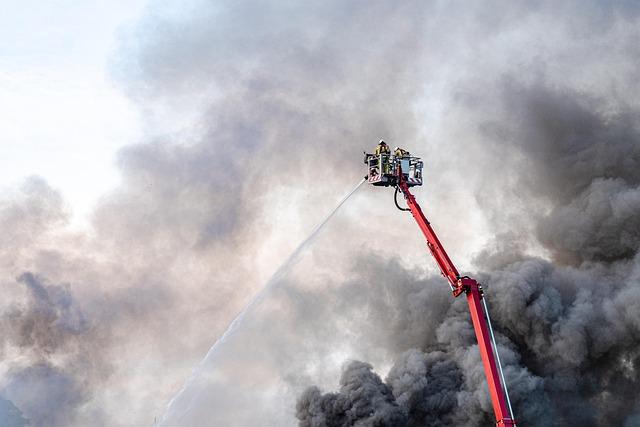Air visitors Management Challenges in Low Visibility Circumstances
Air visitors management (ATC) in low visibility situations presents a myriad of challenges that may place each plane and passengers in danger. Fog, heavy rain, and snow can severely restrict a pilot’s sight throughout strategy and touchdown, making reliance on expertise and communication extra vital than ever. In these conditions, ATC should navigate a fancy array of components, together with:
Enhanced Use of Instrument touchdown Programs (ILS): Floor-based programs assist pilots land safely, however precision is paramount.Separation Requirements: Sustaining protected distances between plane might be elaborate in diminished visibility.Communication Protocols: Clear and concise communication is crucial to forestall misinterpretation and guarantee security.
Furthermore, ATC professionals should make swift selections primarily based on quickly altering situations and the realities of air visitors. The reliance on radar and different detection applied sciences will increase, however even superior programs can wrestle in notably dense fog. Components reminiscent of:
FactorImpactPilot ExperienceInexperienced pilots might discover it more difficult to function in low visibility.Plane TechnologyOlder plane might lack superior navigation programs.Climate VariabilityRapid modifications can have an effect on beforehand established flight paths.
…can jeopardize the security of the operation. Steady coaching and updates on expertise are essential for each ATC and flight crews, permitting for adaptive methods that may safeguard in opposition to potential disasters. In the end, the interaction between people and expertise continues to evolve, necessitating sturdy responses to make sure the safety of life in the air.
Technical Failures and Human Error Contribute to Close to-Miss Incident

The latest incident at the Channel Islands airport highlights a troubling intersection of technical failures and human error that almost led to a catastrophic consequence.A number of components contributed to the near-miss, underscoring the vital nature of stringent security protocols in aviation. Among the many recognized points had been:
Defective Instrumentation: Malfunctions in on-board navigation units created a deceptive image of the plane’s altitude and place.Insufficient Coaching: The flight crew might not have been sufficiently skilled to deal with sudden emergencies that come up from technical anomalies.communication Breakdown: Miscommunication between air visitors management and the cockpit instigated confusion in the course of the strategy in foggy situations.
Evaluation of the incident reveals a regarding development the place developments in expertise can unintentionally contribute to security dangers when not accompanied by sturdy operational protocols.A more in-depth have a look at the timeline of occasions signifies that the failures had been compounded by lapses in judgment from the crew who, underneath strain, might have ignored commonplace working procedures. The important thing factors resulting in the alarming state of affairs embody the next:
TimeEvent09:30Approaching touchdown utilizing defective devices.09:32First communication with air visitors management; misinterpretation of directions.09:34Co-pilot flags altitude concern; miscommunication leads to confusion.09:36Final strategy with inadequate altitude consciousness; near-crash averted.
Emergency Response Measures Activated: A Behind-the-Scenes look

In a tense episode that would have resulted in catastrophe, emergency response groups sprang into motion as a business airliner, navigating by thick fog, approached the runway at Channel Islands Airport. The swift activation of protocols highlights the preparedness of first responders and aviation security officers. As visibility dwindled, the flight crew communicated their dire predicament to air visitors management, prompting fast selections that may finally safeguard the lives on board. Key parts of the emergency response included:
Coordination with Air Visitors Management: Well timed communication ensured a transparent understanding of the plane’s state of affairs.Deployment of Emergency Providers: Firefighters and medical personnel had been put on excessive alert, prepared to reply to potential impacts.Preparation of Runway security Measures: Security obstacles and rescue automobiles had been strategically positioned to mitigate the threat of a crash touchdown.
As the plane descended, floor groups monitored radar and flight information, permitting them to put together for each doable state of affairs. The coordinated efforts of varied businesses concerned introduced a way of calm amidst the potential chaos. A desk under summarizes the key response staff components deployed throughout this vital incident:
Response TeamRoleFire and Rescue ServicesPrepared to douse flames and rescue passengers.Medical Emergency TeamReady to present fast medical assist.Airport OperationsDirected runway security and coordinated evacuations.
Suggestions for Bettering Security Protocols at Regional Airports

To improve security protocols at regional airports, it’s important to implement superior technological options that allow higher situational consciousness for each pilots and air visitors controllers. Investing in improved radar programs and superior climate monitoring applied sciences can considerably scale back the dangers related to low visibility situations, reminiscent of fog. Moreover,establishing real-time communication channels between airports and surrounding air visitors can facilitate well timed updates to pilots,permitting them to make knowledgeable selections throughout difficult climate situations.
Coaching for personnel can be vital in reinforcing security measures. Common drills focusing on emergency response in antagonistic climate ought to be mandated, making certain employees is well-prepared for potential disaster situations. Moreover, enhancing collaboration with native emergency providers can lead to extra efficient response methods. Key suggestions embody:
Common coaching workshops for pilots and floor employees on dealing with antagonistic weatherStandard Working Procedures (SOPs) for low-visibility landingsFrequent security audits to evaluate the effectiveness of current protocolsRecommendationImportanceInvest in superior radar and climate systemsHighImplement common coaching for staffCriticalEnhance communication with emergency servicesEssential
Analyzing the Function of Climate Know-how in Aviation Security

The latest incident involving an airliner narrowly avoiding a crash in dense fog at Channel Islands airport underscores the vital significance of superior climate expertise in aviation security. Trendy aviation depends closely on complicated meteorological programs to forecast climate phenomena that would pose dangers to air journey, such as low visibility situations related to fog. These applied sciences assist pilots and air visitors controllers make knowledgeable selections by offering real-time updates on altering climate patterns, making certain that flights are both diverted or safely guided to land underneath protected situations.With out such expertise, the chance of accidents will increase considerably, as pilots ceaselessly sufficient need to navigate antagonistic climate with out full data.
To additional illustrate the impression of climate expertise in aviation, contemplate the next key developments:
Satellite tv for pc-based programs: Permit for correct monitoring of atmospheric situations over massive areas.Automated climate observing programs (AWOS): Present steady updates on visibility, wind pace, and different vital parameters.Predictive modeling software program: Helps forecast short-term climate patterns that may have an effect on airport operations.Climate radar expertise: Assists in detecting precipitation and turbulent situations in actual time.Know-how TypeFunctionalitysatellite SystemsGlobal atmospheric monitoringAWOSReal-time climate reportingPredictive Modelsshort-term climate forecastingRadar TechnologyDetection of climate anomalies
Neighborhood Response and Implications for Future Air Journey

The latest incident involving an airliner narrowly avoiding catastrophe at a fog-blanketed Channel Islands airport has prompted a wave of concern from each native communities and aviation consultants.The harrowing shut name serves as a stark reminder of the potential hazards related to flying in antagonistic climate situations, significantly in areas the place sudden modifications in visibility can happen. Neighborhood members have voiced their worries, emphasizing the want for improved security measures and higher communication from airways relating to weather-related journey dangers. In mild of this occasion, residents are calling for elevated collaboration between airport authorities and native authorities to make sure that flight operations are performed with the utmost care, particularly during times of low visibility.
Trying forward, the implications of this incident for future air journey are essential. Stakeholders may have to think about the next enhancements:
Enhanced Coaching: Pilots and air visitors controllers might require further simulation coaching particular to navigating low-visibility situations.Technological Developments: Investing in superior radar and navigation programs might enable for higher decision-making throughout hazardous climate situations.Public Consciousness Campaigns: Informing vacationers concerning the potential dangers related to flying throughout poor climate can foster a greater understanding and compliance with security protocols.
Furthermore,many are advocating for the institution of a activity power aimed at analyzing information from near-miss incidents,together with the latest occasion,to facilitate the development of finest apply protocols for airways working in difficult environments. A desk summarizing key suggestions for security enhancements generally is a invaluable device for stakeholders:
RecommendationAction RequiredFlight TrainingUpdate coaching applications for pilots on low-visibility operations.Security TechnologyInvest in cutting-edge navigation programs.Communication StrategiesEnhance communication protocols on climate situations.
Future Outlook
the alarming incident involving an airliner that got here perilously shut to crashing whereas touchdown at Channel Islands airport highlights the ever-present challenges that aviation faces, significantly in antagonistic climate situations. With visibility severely diminished by dense fog, the fast considering and experience of the flight crew had been pivotal in averting catastrophe, underscoring the vital nature of coaching and readiness within the aviation area. This occasion serves as a stark reminder of the potential vulnerabilities in air journey, prompting a renewed dialogue on security protocols and the need for enhanced climate monitoring programs at airports. Because the examination unfolds, the findings will seemingly immediate a radical assessment of operational procedures, making certain that classes are discovered and security is prioritized in future flights.
Source link : https://europ.info/2025/03/09/guernsey-2/airliner-seconds-from-crashing-in-fog-at-channel-islands-airport-the-telegraph/
Creator : Ava Thompson
Publish date : 2025-03-09 05:48:00
Copyright for syndicated content material belongs to the linked Source.



